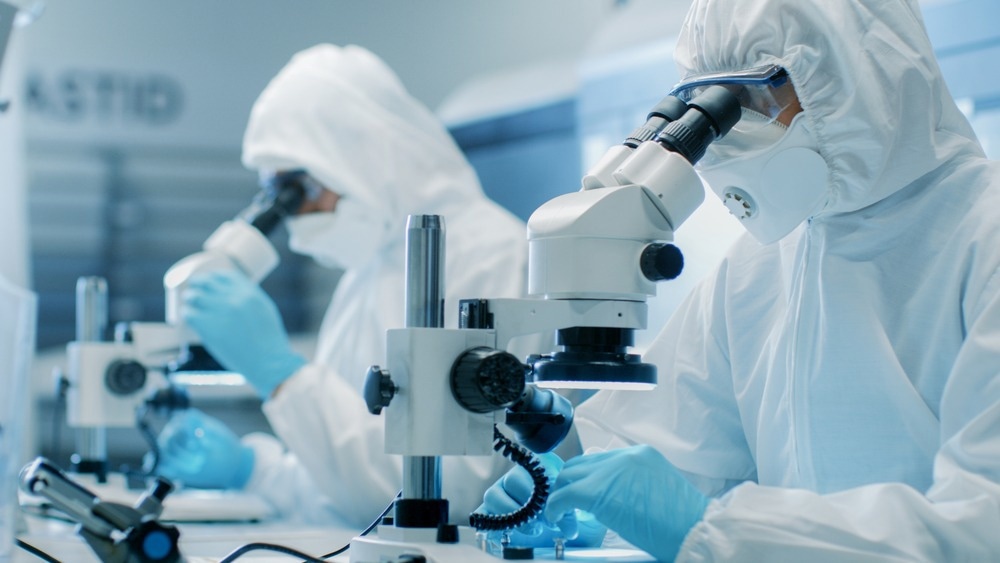Gold nanoparticles serve as plasmonic nanomaterials for the fabrication of optical sensors and are extensively employed in surface-enhanced Raman scattering (SERS) or surface-enhanced infrared absorption (SEIRA) spectroscopy.

Study: Patterning Gold Nanorod Assemblies by Deep-UV Lithography. Image Credit: Gorodenkoff/Shutterstock.com
In an article published in The Journal of Physical Chemistry C, a new method was proposed to pattern the assembly of gold nanorods on substrates, and aggregation-induced near-field coupling of gold nanorods was studied. Controlled deposition of gold nanorods based on deep ultraviolet (UV) lithography generated complex gold nanorod assemblies.
Photoemission electron microscopy (PEEM) was employed on different aggregates of gold nanorods to investigate the near-field coupling. The PEEM results revealed different near-field coupling efficiencies based on the polarization of incident light, angles, and interparticle gaps between the gold nanorods. Here, the near-field hot spots were associated with the interparticle gap.
Assembly of Nanoparticles
Nanoparticles have found potential applications in optics, electronics, and catalysis. Two essential directions of research in this field are the synthesis and self-assembly of nanoparticles. Among the many accessible shapes, anisotropic nanoparticles such as gold nanorods excel due to the straightforward tunability of their localized surface plasmon resonances via chemical adjustment of the nanoparticles’ aspect ratio. This geometrical control allows precise tailoring of the desired excitation wavelength and even achieving optical monodispersity.
The interaction between nanoparticles and light generates specific electrical and optical properties, useful in imaging and other industrial applications. Coherent delocalized electron oscillations at the metal-light interface and localized surface plasmon resonances (LSPRs) are key phenomena based on nanoparticle-light interactions.
Such interactions can be studied at the nanoscale level by employing electron microscopy in electron energy loss mode (EELS), cathodoluminescence microscopy, photoinduced near-field electron microscopy (PINEM), or PEEM.
PEEM is a “photon in/electron out” interaction-based scheme, where the photoemission yield increases based on electromagnetic near-field. The near-field investigation of nanomaterials was pursued using PEEM. The optimization of near-field coupling requires better control over the nanoparticle’s assembly process.
Although sever assembly methods have been previously reported, including surface functionalization, solvent-assisted self-assembly, and funneled traps prepared by lithography, these methods require control over interparticle distance at the nanoscale range and two-dimensional (2D) patterning in the microscale range.
Deep-UV Lithography Towards Patterning of Gold Nanorod Assemblies
In the present work, deep-UV lithography was combined with appropriate deposition conditions to deposit functionalized gold nanorods on silicon wafers and achieve assemblies of gold nanorods with controlled geometries. Subsequently, the use of PEEM on prepared deposits characterized the photoemission of various gold nanorod types, single objects up to large aggregates.
Two deposition methods, droplet and spin-coating, were adopted for depositing gold nanorods on substrates. In the droplet method, gold nanorods were assembled on a silicon wafer near the droplet evaporation front that differed based on the relative orientation of the evaporation front to the hydrophilic bands, indicating the impact of surface functionalization of the substrate on the nanoparticle’s assembly.
The droplet method resulted in the aggregation of elongated gold nanorods and multilayered gold nanorods in some parts of the assemblies. Here, the inhomogeneous evaporation resulted in local defects, suggesting the sensitivity of nanoparticle aggregation towards solvent evaporation rate.
Furthermore, the spin-coating method was optimized to combat the issue of local defects obtained via the droplet method. It was observed that the spin-coating method significantly improved the deposition of gold nanorods by enhancing the deposition selectivity and monolayer nature.
While the droplet method resulted in substrates with a high density of gold nanorods, the spin-coating process increased the deposition selectivity and monolayer nature. Moreover, from the geometrical point of view, single and dimer gold nanorods were the building blocks of gold nanorod aggregates.
The ordering of gold nanorods is critical for developing efficient metamaterials with unique properties. The near-field distribution was the characteristic of dipolar plasmon resonance with hot spots of the electric field observed at a particular contact site. For example, for single gold nanorods, the hotspots were observed at the object ends.
Conclusion
To summarize, a new method for the assembly of gold nanorods (nanoparticles) on the surface of the substrates (silicon wafers) was demonstrated. Here, functionalizing gold nanorods with polyelectrolytes helped in their adsorption on hydrophilic strips of the modified surface.
Two methods of nanoparticle deposition, namely, spin-coating and droplet evaporation, were investigated in the present work. Among them, the spin coating-based deposition method maximized the selectivity and monolayer nature of the aggregates.
The arrangement of gold nanorods is critical for developing efficient metamaterials with outstanding properties. Moreover, the near-field electromagnetic behavior of the nanoparticles is directly related to their aggregate ordering. Observing various types of gold nanorods (monomers/dimers/aggregates) under PEEM and electromagnetic simulation helped characterize the near-field optics of gold nanorod assemblies.
Reference
Jégat, C., Rollin, E., Douillard, L., Soppera, O., Nakatani, K., Laurent, G et al. (2022). Patterning Gold Nanorod Assemblies by Deep-UV Lithography. The Journal of Physical Chemistry C. https://pubs.acs.org/doi/10.1021/acs.jpcc.2c03047
Disclaimer: The views expressed here are those of the author expressed in their private capacity and do not necessarily represent the views of AZoM.com Limited T/A AZoNetwork the owner and operator of this website. This disclaimer forms part of the Terms and conditions of use of this website.

